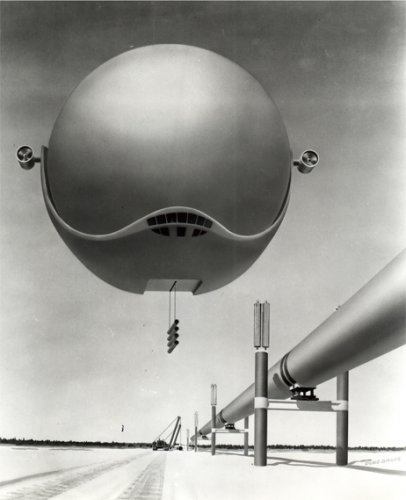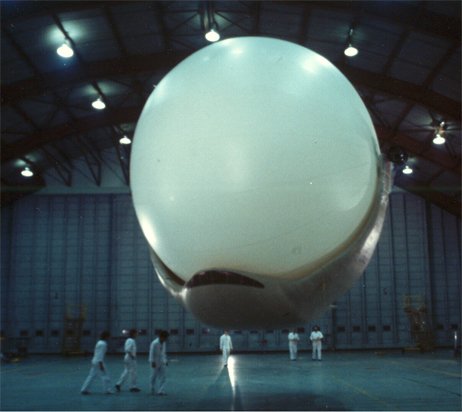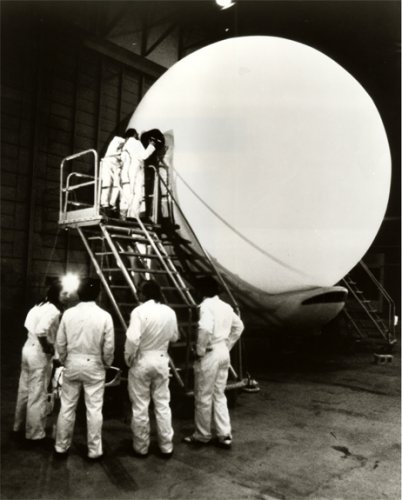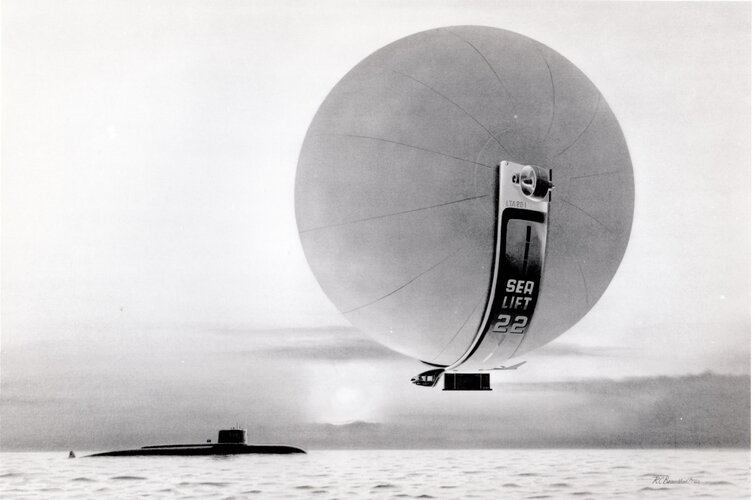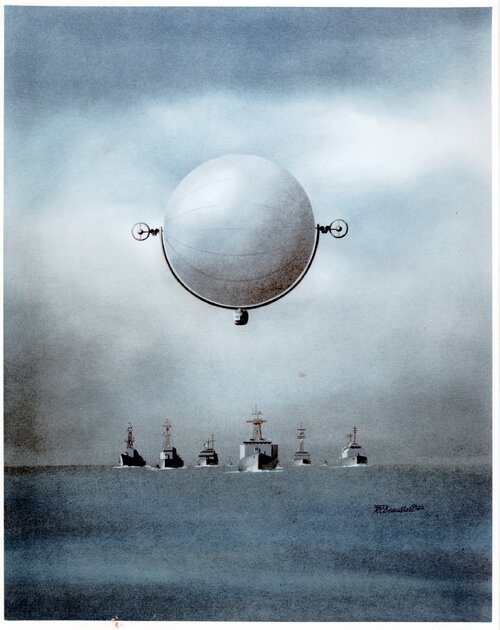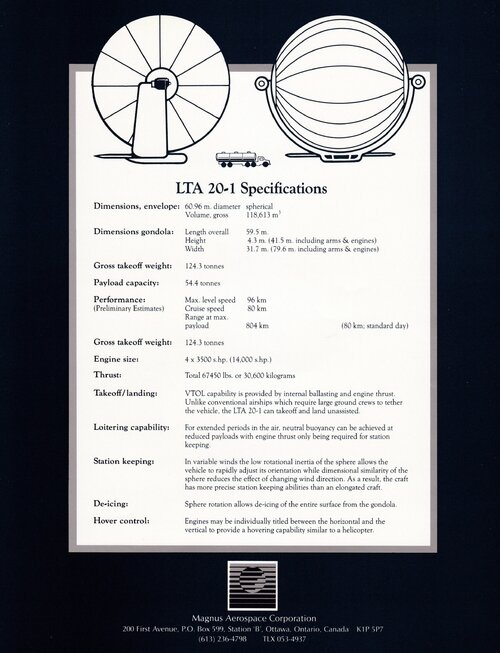You are using an out of date browser. It may not display this or other websites correctly.
You should upgrade or use an alternative browser.
You should upgrade or use an alternative browser.
Van Dusen LTA 20 « Magnus » spherical airship prototype (1982)
- Thread starter Triton
- Start date
I was under the impression there was a flaw in the theory/design of the Magnus and that it didn't work as it was supposed to. Any information on this?Triton said:Magnus Spherical Airship
Randy
- Joined
- 9 October 2009
- Messages
- 21,129
- Reaction score
- 12,215
RanulfC said:I was under the impression there was a flaw in the theory/design of the Magnus and that it didn't work as it was supposed to. Any information on this?Triton said:Magnus Spherical Airship
Randy
IIRC, it was great at lifting extremely heavy/outsized loads, but it's downfall was that it's spherical shape turned out to be high drag at anything resembling high speeds, which limited the design's utility.
The audio quality is fairly horrifying, but at least it's free:
http://www.youtube.com/watch?v=GPiPdIs9b5U
http://www.youtube.com/watch?v=GPiPdIs9b5U
SlickDriver
ACCESS: Confidential
- Joined
- 20 June 2006
- Messages
- 161
- Reaction score
- 33
Loved that show - have them on DVD
- Joined
- 13 June 2007
- Messages
- 2,099
- Reaction score
- 2,698
Greetings All -Loved that show - have them on DVD
Came across this AvWeek article on the LTA 20 in a recent Museum donation....
Enjoy the Day! Mark
Attachments
Hoping that what follows does not repeat what is found above.
Van Dusen Commercial Development (Canada) of Ottawa began to take an interest in airships around February 1978. A market study enabled it to specify the configuration of an airship more efficient than its predecessors. Radical in appearance to say the least, the LTA-20 flying crane had a circular envelope rather than a cigar-shaped one. Said envelope contained helium put under pressure. It rotated around the horizontal axis which supported the command pod to create lift.
This was an original application of the Magnus effect, to say the least, an effect described but not discovered in 1852 by the German physicist Heinrich Gustav Magnus. The Magnus Effect explains, for example, the behavior of balls in sports such as baseball, golf and table tennis.
Van Dusen Commercial Development (Canada) began manufacturing a demonstration model of the LTA-20 in May 1981. This radio-controlled model made its maiden flight in October. In 1983, the management considered the possibility of transferring the project to Europe. That project failed. Also in 1983, a team from the University of Toronto Institute for Aerospace Studies which included James Duncan DeLaurier carried out research to improve the concept. Three different scale radio-controlled demo models flew in 1984. Van Dusen Commercial Development (Canada) wished to complete a piloted proof-of-concept prototype but may not have started construction. The activities during the 1990s of Magnus Aerospace Corporation, a name adopted around 1985, went beyond the work I did years ago. Apologies. That said, the point is that the company's plans did not result in any series production.
Van Dusen Commercial Development (Canada) of Ottawa began to take an interest in airships around February 1978. A market study enabled it to specify the configuration of an airship more efficient than its predecessors. Radical in appearance to say the least, the LTA-20 flying crane had a circular envelope rather than a cigar-shaped one. Said envelope contained helium put under pressure. It rotated around the horizontal axis which supported the command pod to create lift.
This was an original application of the Magnus effect, to say the least, an effect described but not discovered in 1852 by the German physicist Heinrich Gustav Magnus. The Magnus Effect explains, for example, the behavior of balls in sports such as baseball, golf and table tennis.
Van Dusen Commercial Development (Canada) began manufacturing a demonstration model of the LTA-20 in May 1981. This radio-controlled model made its maiden flight in October. In 1983, the management considered the possibility of transferring the project to Europe. That project failed. Also in 1983, a team from the University of Toronto Institute for Aerospace Studies which included James Duncan DeLaurier carried out research to improve the concept. Three different scale radio-controlled demo models flew in 1984. Van Dusen Commercial Development (Canada) wished to complete a piloted proof-of-concept prototype but may not have started construction. The activities during the 1990s of Magnus Aerospace Corporation, a name adopted around 1985, went beyond the work I did years ago. Apologies. That said, the point is that the company's plans did not result in any series production.
I can almost see an orbital ECHO balloon with a fast tracking dish inside with the underslung pod and a gravity gradient keel. Or a central feed horn with half the sphere transparent on the outside and reflective inside-electronic tint like.
- Joined
- 3 September 2006
- Messages
- 1,429
- Reaction score
- 1,348
In this picture of the dinosaur above the fleet, any wrong wind gust might cause alot of damage.
... Which somehow is precisely how most giant LTAs ended up. Looks like some people never learn.
... Which somehow is precisely how most giant LTAs ended up. Looks like some people never learn.
the lower component very much has the aesthetic look of the 'martian war machine' from the George Pal 'War of the Worlds' film
Similar threads
-
Lockheed Martin LMH-1 heavy-lift hybrid airship
- Started by Triton
- Replies: 5
-
Goodyear "Dynastat" giant transport projects
- Started by Stargazer
- Replies: 2
-
-
Airborne Fleet Air Defense System - MSDF
- Started by Grey Havoc
- Replies: 6
-
Mobile Protected Weapon System (MPWS) / Mobile Protected Gun System (MPGS) Piranha - 75mm XM274 MCAAC on GM Canada Piranha 8x8
- Started by Hydroxideblue
- Replies: 8

